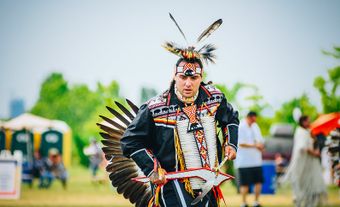Canada has 38 national parks (and 10 national park reserves; see also National Parks of Canada). They protect important land and marine habitats, geographical features and sites of cultural significance. National parks also benefit local economies and the tourism industry in Canada. In total, the parks cover more than 340,000 km2, which is over 3 per cent of Canada’s landmass. Nearly all of Canada’s largest national parks are located in the north, and five of them in Nunavut.
1. Wood Buffalo National Park, 44,741 km2

Straddling the border between Alberta and the Northwest Territories, Wood Buffalo National Park is larger than Denmark. It was established in 1922 to protect the last herd of wood bison, and today is also home to the world’s only natural nesting site for whooping cranes. The park was declared a world heritage site in 1983.
2. Quttinirpaaq National Park, 37,775 km2
First known as Ellesmere Island National Park, Quttinirpaaq (pronounced koo-tin-ir-pa-ak) is Canada’s most northerly national park and some of the most northerly land in North America. Its Inuktitut name, taken in 1999, means “land at the top of the world.” Access is by air from Resolute, Nunavut.
3. Sirmilik National Park, 22,252 km2

Sirmilik National Park comprises three separate land components in Nunavut: the land on either side of Oliver Sound, Bylot Island, and part of the Borden Peninsula.The park was first established as a bird sanctuary because of its impressive seabird colonies, including thick-billed murres and black-legged kittiwakes. Sirmilik (pronounced Seer-mee-leek) is an Inuktitut word that means “place of glaciers.”
4. Ukkusiksalik National Park, 20,885 km2
Ukkusiksalik National Park surrounds a spectacular inland sea called Wager Bay, in Nunavut. The name Ukkusiksalik (pronounced Ooooo-koo-sik-sa-lik)in Inuktitut means “the place where soapstone to make pots and oil lamps is found.”
5. Auyuittuq National Park, 19,089 km2
Located on the Cumberland Peninsula of Baffin Island, Nunavut, Auyuittuq National Park is a harsh land of barren tundra, jagged mountain peaks, deep fjords and ice. Auyuittuq (pronounced Ow-you-eet-took) means “land that never melts” in Inuktitut.
6. Tuktut Nogait National Park, 18,890 km2
Tuktut Nogait National Park, located in the Northwest Territories, is a rolling tundra landscape deeply incised by the Hornaday, Brock and Roscoe rivers. It is an important calving ground for a population of barren-ground caribou. The name Tuktut Nogait (pronounced Took-toot Noo-guy-t) means “caribou calves” in Inuvialuktun.
7. Aulavik National Park, 12,200 km2
Aulavik National Park is centred on the wide Thomsen River valley on Banks Island, Northwest Territories. The Thomsen River valley is the most productive area in the world for muskoxen. Aulavik (pronounced Ow-lah-veek) means “where people travel” in Inuvialuktun.
8. Wapusk National Park, 11,475 km2
Wapusk National Park national park extends to the east and south of Churchill, Manitoba. It protects a representative sample of the features and wildlife of the Hudson and James Bay lowlands. Wapusk is Cree for “white bear,” referring to polar bears.
9. Qausuittuq National Park, 11,000 km2

Qausuittuq National Park is located on northern Bathurst Island and smaller surrounding islands in Nunavut. It also includes the waters of May Inlet and Young Inlet. Qausuittuq (pronounced Kow-soo-ee-took) translates to “the place where the sun doesn’t rise” in Inuktitut. It is bordered to the south by Polar Bear Pass National Wildlife Area, and together these two zones protect a large, ecologically intact area in the Canadian Arctic Archipelago.
10. Jasper National Park, 10,878 km2
Jasper National Park is located about 370 km west of Edmonton, Alberta. It is one of seven parks in the Rocky Mountains that make up the Canadian Rocky Mountain Parks UNESCO World Heritage site (the others are Yoho, Banff and Kootenay national parks, and Mount Robson, Mount Assiniboine and Hamber provincial parks). Among the reasons for the UNESCO designation are the parks’ mountain landscapes, complete with waterfalls, canyons and glaciers, including those found in the Columbia Icefield.

 Share on Facebook
Share on Facebook Share on X
Share on X Share by Email
Share by Email Share on Google Classroom
Share on Google Classroom



